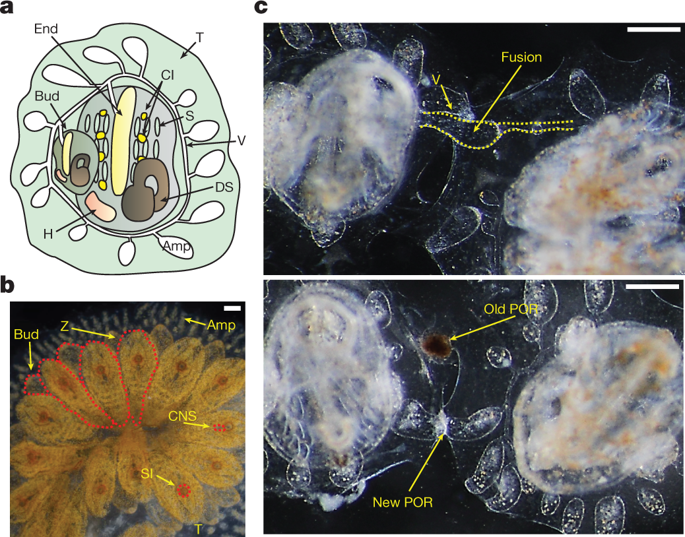Our official English website, www.x-mol.net, welcomes your
feedback! (Note: you will need to create a separate account there.)
Complex mammalian-like haematopoietic system found in a colonial chordate
Nature ( IF 50.5 ) Pub Date : 2018-12-01 , DOI: 10.1038/s41586-018-0783-x Benyamin Rosental 1, 2 , Mark Kowarsky 3 , Jun Seita 1, 4 , Daniel M Corey 1 , Katherine J Ishizuka 1, 2 , Karla J Palmeri 1, 2 , Shih-Yu Chen 5 , Rahul Sinha 1 , Jennifer Okamoto 6 , Gary Mantalas 7, 8 , Lucia Manni 9 , Tal Raveh 1 , D Nathaniel Clarke 2 , Jonathan M Tsai 1 , Aaron M Newman 1 , Norma F Neff 6 , Garry P Nolan 5 , Stephen R Quake 6, 7 , Irving L Weissman 1, 2, 10 , Ayelet Voskoboynik 1, 2
Nature ( IF 50.5 ) Pub Date : 2018-12-01 , DOI: 10.1038/s41586-018-0783-x Benyamin Rosental 1, 2 , Mark Kowarsky 3 , Jun Seita 1, 4 , Daniel M Corey 1 , Katherine J Ishizuka 1, 2 , Karla J Palmeri 1, 2 , Shih-Yu Chen 5 , Rahul Sinha 1 , Jennifer Okamoto 6 , Gary Mantalas 7, 8 , Lucia Manni 9 , Tal Raveh 1 , D Nathaniel Clarke 2 , Jonathan M Tsai 1 , Aaron M Newman 1 , Norma F Neff 6 , Garry P Nolan 5 , Stephen R Quake 6, 7 , Irving L Weissman 1, 2, 10 , Ayelet Voskoboynik 1, 2
Affiliation

|
Haematopoiesis is an essential process that evolved in multicellular animals. At the heart of this process are haematopoietic stem cells (HSCs), which are multipotent and self-renewing, and generate the entire repertoire of blood and immune cells throughout an animal’s life1. Although there have been comprehensive studies on self-renewal, differentiation, physiological regulation and niche occupation in vertebrate HSCs, relatively little is known about the evolutionary origin and niches of these cells. Here we describe the haematopoietic system of Botryllus schlosseri, a colonial tunicate that has a vasculature and circulating blood cells, and interesting stem-cell biology and immunity characteristics2–8. Self-recognition between genetically compatible B. schlosseri colonies leads to the formation of natural parabionts with shared circulation, whereas incompatible colonies reject each other3,4,7. Using flow cytometry, whole-transcriptome sequencing of defined cell populations and diverse functional assays, we identify HSCs, progenitors, immune effector cells and an HSC niche, and demonstrate that self-recognition inhibits allospecific cytotoxic reactions. Our results show that HSC and myeloid lineage immune cells emerged in a common ancestor of tunicates and vertebrates, and also suggest that haematopoietic bone marrow and the B. schlosseri endostyle niche evolved from a common origin.The identification of a complex haematopoietic system in a colonial tunicate sheds light on the evolution of the mammalian blood system.
中文翻译:

在殖民脊索动物中发现复杂的类似哺乳动物的造血系统
造血是多细胞动物进化的一个重要过程。这一过程的核心是造血干细胞 (HSC),它们具有多能性和自我更新性,可在动物的一生中产生全部血液和免疫细胞1。尽管对脊椎动物造血干细胞的自我更新、分化、生理调节和生态位占据进行了全面的研究,但对这些细胞的进化起源和生态位的了解相对较少。在这里,我们描述了灰霉病(Botryllus schlosseri)的造血系统,这是一种具有脉管系统和循环血细胞的群体性被囊动物,以及有趣的干细胞生物学和免疫特征2-8。遗传相容的 B. schlosseri 菌落之间的自我识别导致形成具有共享循环的天然副生物,而不相容的菌落则相互排斥3,4,7。使用流式细胞术、特定细胞群的全转录组测序和多种功能测定,我们鉴定了 HSC、祖细胞、免疫效应细胞和 HSC 生态位,并证明自我识别抑制同种异体特异性细胞毒性反应。我们的研究结果表明,HSC 和髓系免疫细胞出现在被囊动物和脊椎动物的共同祖先中,并且还表明造血骨髓和 B. schlosseri 内风格生态位是从共同起源进化而来的。被囊动物揭示了哺乳动物血液系统的进化。
更新日期:2018-12-01
中文翻译:

在殖民脊索动物中发现复杂的类似哺乳动物的造血系统
造血是多细胞动物进化的一个重要过程。这一过程的核心是造血干细胞 (HSC),它们具有多能性和自我更新性,可在动物的一生中产生全部血液和免疫细胞1。尽管对脊椎动物造血干细胞的自我更新、分化、生理调节和生态位占据进行了全面的研究,但对这些细胞的进化起源和生态位的了解相对较少。在这里,我们描述了灰霉病(Botryllus schlosseri)的造血系统,这是一种具有脉管系统和循环血细胞的群体性被囊动物,以及有趣的干细胞生物学和免疫特征2-8。遗传相容的 B. schlosseri 菌落之间的自我识别导致形成具有共享循环的天然副生物,而不相容的菌落则相互排斥3,4,7。使用流式细胞术、特定细胞群的全转录组测序和多种功能测定,我们鉴定了 HSC、祖细胞、免疫效应细胞和 HSC 生态位,并证明自我识别抑制同种异体特异性细胞毒性反应。我们的研究结果表明,HSC 和髓系免疫细胞出现在被囊动物和脊椎动物的共同祖先中,并且还表明造血骨髓和 B. schlosseri 内风格生态位是从共同起源进化而来的。被囊动物揭示了哺乳动物血液系统的进化。











































 京公网安备 11010802027423号
京公网安备 11010802027423号